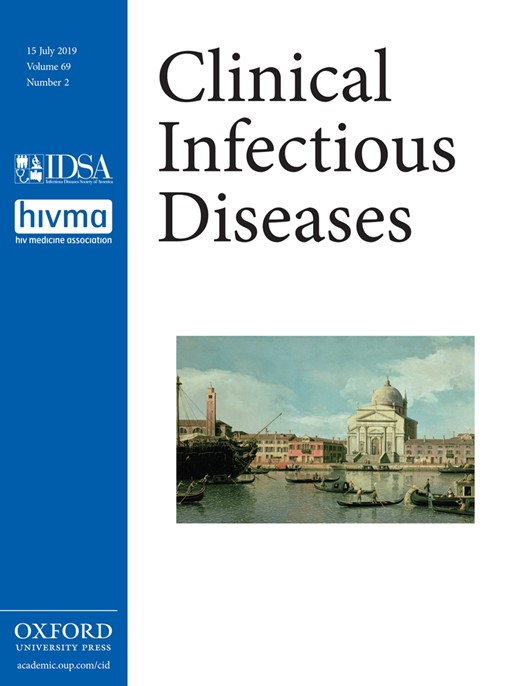
Cover image

Volume 69, Issue 2, 15 July 2019
NEWS
News
IN THE LITERATURE
In the Literature
ARTICLES AND COMMENTARIES
Severe Morbidity and Mortality Associated With Respiratory Syncytial Virus Versus Influenza Infection in Hospitalized Older Adults
Older adults hospitalized with respiratory syncytial virus (RSV) or influenza were compared. RSV infection was associated with longer hospitalization and greater odds of pneumonia, intensive care unit admission, and 1-year mortality. Recognition of adult RSV disease is needed to facilitate future vaccination and treatment.
Why Making a Diagnosis of Respiratory Syncytial Virus Should Matter to Clinicians
Impact of Next-generation Sequencing Defined Human Immunodeficiency Virus Pretreatment Drug Resistance on Virological Outcomes in the ANRS 12249 Treatment-as-Prevention Trial
We documented a high prevalence of pretreatment drug resistance (PDR) among participants enrolled in trial clinics in rural KwaZulu-Natal. Dual-class PDR to a first-line tenofovir/emtricitabine/efavirenz regimen was associated with poorer virological suppression. However, there was no impact of nonnucleoside reverse transcriptase inhibitor PDR alone.
The Clinical Implications of Pretreatment Drug Resistance—A Moving Target
Severe Pertussis Infections in the United States, 2011–2015
Infants aged <2 months are at greatest risk for pertussis-related hospitalization, and severe pertussis infections occur in persons of all ages. Pertussis vaccination remains the most important tool for the prevention of severe infection.
The Impact of a National Antimicrobial Stewardship Program on Antibiotic Prescribing in Primary Care: An Interrupted Time Series Analysis
This study aimed to evaluate the association between antimicrobial stewardship with financial incentive and a reduction of antibiotic prescribing. This study shows that pay-for-performance can significantly reduce antibiotic use: specifically, the use of broad-spectrum antibiotics.
An Assessment of Potential Unintended Consequences Following a National Antimicrobial Stewardship Program in England: An Interrupted Time Series Analysis
This study aimed to evaluate possible unintended clinical outcomes related to an antimicrobial program with financial incentive. This study shows that overall there was no significant association between the intervention and unintended clinical consequences in primary and secondary care.
Diarrheal Etiology and Impact of Coinfections on Rotavirus Vaccine Efficacy Estimates in a Clinical Trial of a Monovalent Human–Bovine (116E) Oral Rotavirus Vaccine, Rotavac, India
Quantitative molecular testing of stool samples for enteropathogens from diarrheal episodes from a phase 3 rotavirus vaccine efficacy trial revealed high coinfection rates, and there was a 11.3% improvement in vaccine efficacy estimates after accounting for these coinfections.
Quantifying the Infectiousness of Post-Kala-Azar Dermal Leishmaniasis Toward Sand Flies
We report xenodiagnosis results for 47 post-kala-azar dermal leishmaniasis (PKDL) and 15 visceral leishmaniasis (VL) patients. Skin parasite load was strongly associated with positive xenodiagnosis. Compared to VL (66.7%), nodular PKDL was more likely (86%) and macular PKDL less likely (35%) to result in positive xenodiagnosis.
Linezolid- and Vancomycin-resistant Enterococcus faecium in Solid Organ Transplant Recipients: Infection Control and Antimicrobial Stewardship Using Whole Genome Sequencing
A vancomycin-resistant enterococci outbreak occurred in a large organ transplant center and remained undetected due to limitations of conventional testing methods. Whole genome sequencing revealed a subpopulation of organisms harboring the G2576C mutation affecting 23S ribosomal RNA and conferring resistance to linezolid.
Laboratory Antimicrobial Stewardship During an Outbreak of Linezolid- and Vancomycin-resistant Enterococcus faecium Bacteremia
Gut Dysbiosis With Bacilli Dominance and Accumulation of Fermentation Products Precedes Late-onset Sepsis in Preterm Infants
In a large cohort of preterm neonates, a Bacilli-mediated intestinal dysbiosis with a lack of anaerobic bacteria and an accumulation of fermentation products preceded the development of sepsis. These data offer potential biomarkers and therapeutic targets for prevention of sepsis.
Mass Drug Administration With Dihydroartemisinin-piperaquine and Malaria Transmission Dynamics in The Gambia: A Prospective Cohort Study
Annual mass drug administration (MDA) with dihydroartemisinin-piperaquine over 2 years reduced the incidence of malaria infection and clinical disease, but was not sustained in eastern Gambia. Multiple MDA rounds over large areas may result in larger and sustained transmission reductions.
Mass Drug Administration to Control and Eliminate Malaria in Africa: How Do We Best Utilize the Tools at Hand?
Frequent Door Openings During Cardiac Surgery Are Associated With Increased Risk for Surgical Site Infection: A Prospective Observational Study
Frequent door openings during cardiac surgery were independently associated with an increased risk for surgical site infection (SSI). This finding warrants further study to establish a potentially causal relationship between door openings and the occurrence of SSIs.
Plasma Biomarkers to Detect Prevalent or Predict Progressive Tuberculosis Associated With Human Immunodeficiency Virus–1
In prevalent tuberculosis (TB), incident TB, and control samples, we evaluated 13 plasma biomarkers to identify individuals infected with human immunodeficiency virus–1 who were susceptible to active TB: biomarkers differentiated prevalent TB from control samples, but not incident TB.
The Clinical Impact and Cost-effectiveness of Measles-Mumps-Rubella Vaccination to Prevent Measles Importations Among International Travelers From the United States
A pretravel measles-mumps-rubella (MMR) vaccination could offer good value or be cost saving for travelers with a higher risk of measles exposure, especially if they are previously unvaccinated or returning to a US community with heterogeneous MMR coverage.
Therapeutic Impact of Initial Treatment for Chlamydia trachomatis Among Patients With Pelvic Inflammatory Disease: A Retrospective Cohort Study Using a National Inpatient Database in Japan
Using a national inpatient database, 27841 patients diagnosed with pelvic inflammatory disease were identified. Initial treatment for Chlamydia trachomatis was significantly associated with less surgical intervention and lower mortality rate by propensity score–matched analysis.
Integrated, Co-located, Telemedicine-based Treatment Approaches for Hepatitis C Virus Management in Opioid Use Disorder Patients on Methadone
Telemedicine can virtually integrate treatment for hepatitis C virus (HCV) into the opioid substitution therapy program with virological outcomes equivalent to those in clinical trials. Analysis of psychosocial and demographic variables can also identify patients willing to pursue HCV therapy.
Long-term Quality of Life in Adult Patients Surviving Purpura Fulminans: An Exposed-Unexposed Multicenter Cohort Study
Long-term health-related quality of life does not significantly differ between patients surviving purpura fulminans (PF) and those surviving septic shock unrelated to PF. PF survivors who required limb amputation have an impaired long-term physical health-related quality of life but a preserved mental health.
BRIEF REPORTS
The Epidemiology of Herpes Zoster in the United States During the Era of Varicella and Herpes Zoster Vaccines: Changing Patterns Among Older Adults
The Epidemiology of Herpes Zoster in the United States During the Era of Varicella and Herpes Zoster Vaccines: Changing Patterns Among Children
Characterization of Virus-specific Immune Response During Varicella Zoster Virus Encephalitis in a Young Adult
VIEWPOINTS
Infectious Diseases Physicians: Improving and Protecting the Public’s Health: Why Equitable Compensation Is Critical
Infectious diseases (ID) physicians perform valuable roles protecting public health, but many of their activities are poorly compensated. Compensation policy changes are needed to allow the ID field to continue to attract the best and brightest medical students and residents.
REVIEW ARTICLE
Birth Cohort Studies Assessing Norovirus Infection and Immunity in Young Children: A Review
Birth cohort studies show that noroviruses are high-incidence pathogens associated with diarrhea among young children, particularly those aged ≥6 months in low/middle-income countries. Evidence for immunity and genetically determined risk factors are provided and important limitations and considerations are discussed.
INVITED ARTICLE
CLINICAL PRACTICE
The Juncture Between Clostridioides difficile Infection and Inflammatory Bowel Diseases
The detection of Clostridium difficile in inflammatory bowel disease (IBD) patients is a common occurrence. Here, we review the epidemiology, clinical presentation, risk factors, diagnosis, treatment, and outcomes of IBD patients with positive C. difficile tests.



